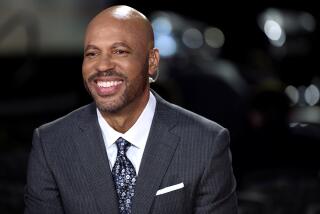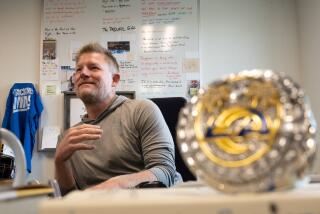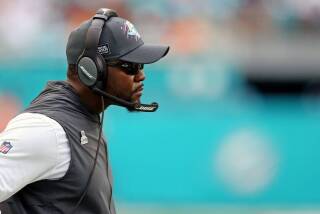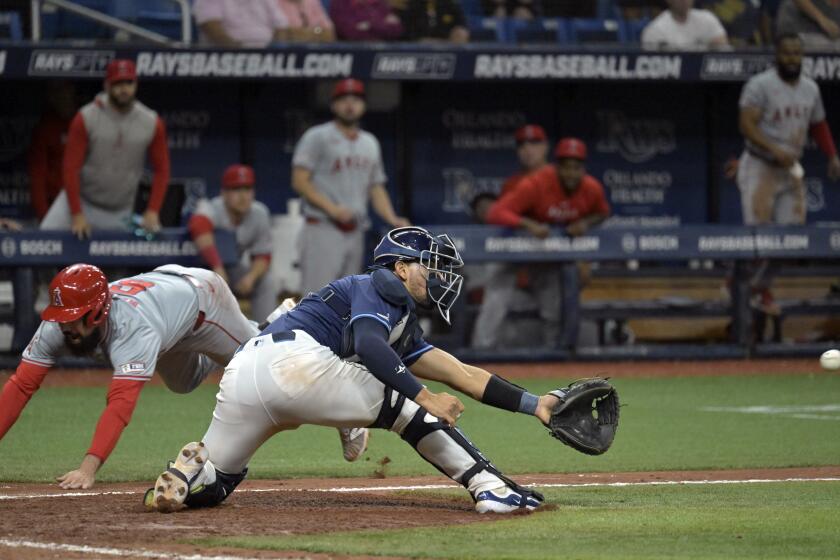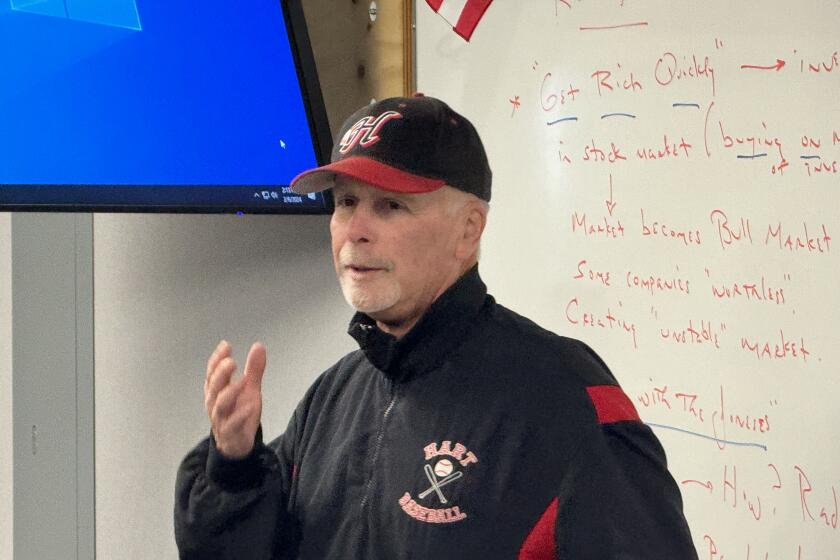NFL labor talks mediator is down in the trenches
Reporting from Washington
The fragile future of the country’s most successful sports league is being shaped in a blockish, brown building on the corner of K and 21st streets in the nation’s capital. That’s where pro football’s labor negotiations are taking place.
There, at the Federal Mediation and Conciliation Services, the NFL has taken over one floor, and the NFL Players Assn. another.
Each side has a headquarters on its floor, cramped rooms filled with papers and computer terminals. People constantly bustle in and out, giving the stuffy confines the feel of a campaign office.
The NFL and NFLPA have agreed to push the collective bargaining deadline back a week, until Friday turns to Saturday on the East Coast, in hopes that their differences can be resolved through mediation. They resume Monday for their 12th day of talks.
“This is going to get resolved through negotiations,” NFL Commissioner Roger Goodell said. “Not through litigation. So talking is better than litigating.”
Lined up on the sidewalk in front of the building are at least a dozen TV cameras. Clusters of reporters are bundled against the cold, as the temperature drops to near freezing when the sun dips below the skyline. Information is dispensed at a slow, infrequent drip, and the wait can take hours.
On the other side of a revolving door is the building’s lobby, and any flicker of movement in there — a security guard walking through, a secretary heading home — stirs the media to attention. Most everything is a false alarm. Motorists drive by slowly, surely wondering what’s causing the fuss.
When anyone from either side actually says something — and it’s not much — it’s as cryptic and carefully worded as if a bomb is being defused.
And, in a sense, one is.
The sides, deeply divided on how to share the league’s $9 billion in annual revenue, have turned to mediation as a last resort before turning to their most extreme measures. Each has its finger on the nuclear button, with the league threatening to lock out the players, and the union ready to decertify and therefore strip owners of their antitrust exemption.
In the middle is FMCS Director George H. Cohen, appointed by President Obama in 2009 and unanimously approved by the U.S. Senate. A longtime labor lawyer, Cohen has transitioned to mediation and last year helped broker a deal that averted a Major League Soccer labor meltdown.
“The parties couldn’t be in better hands,” said Stanford law professor William Gould, a former chairman of the National Labor Relations Board who has known Cohen since they were young NLRB lawyers in the 1960s. “This is a guy who brings an awful lot in terms of knowledge and temperament to the table.”
Whereas the MLS resolution was a few paragraphs buried in the sports page, the NFL saga is the biggest sports story of the year, one that threatens to derail pro football for the first time since the players’ strike in 1987. Even Obama weighed in on the issue when asked about it last week.
“I’m a big football fan,” he said, “but I also think that for an industry that’s making $9 billion a year in revenue, they can figure out how to divide it up in a sensible way and be true to their fans, who are the ones who obviously allow for all the money that they’re making.
“So my expectation and hope is that they will resolve it without me intervening. Because it turns out I’ve got a lot of other stuff to do.”
At the moment, Cohen is the man in the middle. There is a big difference between arbitration and mediation, both of which are often conducted by former practicing lawyers and judges. An arbitrator participates in a far more formal hearing and can issue a binding award and an opinion that supports it. A mediator is more like a counselor, someone who has no authority to compel the parties to do anything. A mediator can, at most, recommend — knowing that either side can break off talks at any point.
That makes it a more delicate and nuanced art, one that calls on patience, creativity, and frequently round-the-clock hours, as opposed to the more structured 9-to-5 schedule of an arbitrator.
“Mediation can be anything,” Gould said, “all the way from carrying the coffee back and forth to the parties and sitting there like a bump on a log and listening, to actively proposing settlements and answers.”
According to the FMCS, about 85% of all contract disputes mediated by the agency in recent years have ended with agreements.
Agent Leigh Steinberg said a good mediator is “an expert in the psychology of human gridlock,” and very early pulls each party aside and points out the weaknesses in its arguments.
“He’ll cut through the defensiveness and surface rhetoric to get to the bottom line,” Steinberg said. “Skilled mediators have the ability to paint a picture and look into the future, to sketch like in ‘A Christmas Carol’ the ghosts of conflicts past, present and future.”
Clearly, that strategy has worked in the volatile NFL negotiations because both sides are still at the table. Participating at various times for the league are its top lawyers, executives and occasionally team owners. On the side of the union are lawyers and executives — among them Executive Director DeMaurice Smith — and players who serve as union representatives on their teams.
Smith has publicly assured football fans “we’re not going to let you down.”
Cohen has broken the parties into small groups, and occasionally brings them all together in one room. In those large sessions, the topics and financial numbers are discussed in broader terms. Cohen and his staff are exceedingly polite with the participants, constantly shuttle from room to room, and provide help whenever they can.
“Gradually, piece by piece, a good mediator will shape a consensus by letting some guys know their risk, letting some guys know their common ground, and by getting some guys to meet in the middle,” said David Baker, former commissioner of the Arena Football League who negotiated three CBAs with AFL players (who were also represented by the NFLPA). “It’s an extremely fragile relationship.”
Gould, who has worked as a mediator and wrote the soon-to-be-released book “Bargaining With Baseball,” said the process of holding the parties together can be “exhausting” and that it’s not uncommon “to look up from your work and it’s 6 in the morning with the sun rising.”
In addition to being the AFL’s former top executive, Baker is the father of Atlanta Falcons tackle Sam Baker, so he’s paying close attention to the NFL’s mediation, if only from afar.
Speaking of mediations in general, David Baker said: “There’s a lot of hallway strategies. There’s a lot of sandwiches that are ordered in. There’s a lot of being in the same clothes for too long. There’s never really a time when you’re alone.”
Baker added that negotiating your case before a mediator can feel a little like living with your in-laws, which can make things stressful yet can add some much-needed civility to the process.
“It’s somebody who you’re not quite sure whether he’s on your side or not, because he’s hearing both sides of it,” Baker said. “He probably knows more about you than you would like, because he’s heard it from the other side. And you can never really let your hair down. Even if they’re in-laws, they’re still your parents.
“You want to set forth the facts, but you don’t want to seem unreasonable about it.”
twitter.com/LATimesfarmer
More to Read
Get our high school sports newsletter
Prep Rally is devoted to the SoCal high school sports experience, bringing you scores, stories and a behind-the-scenes look at what makes prep sports so popular.
You may occasionally receive promotional content from the Los Angeles Times.
